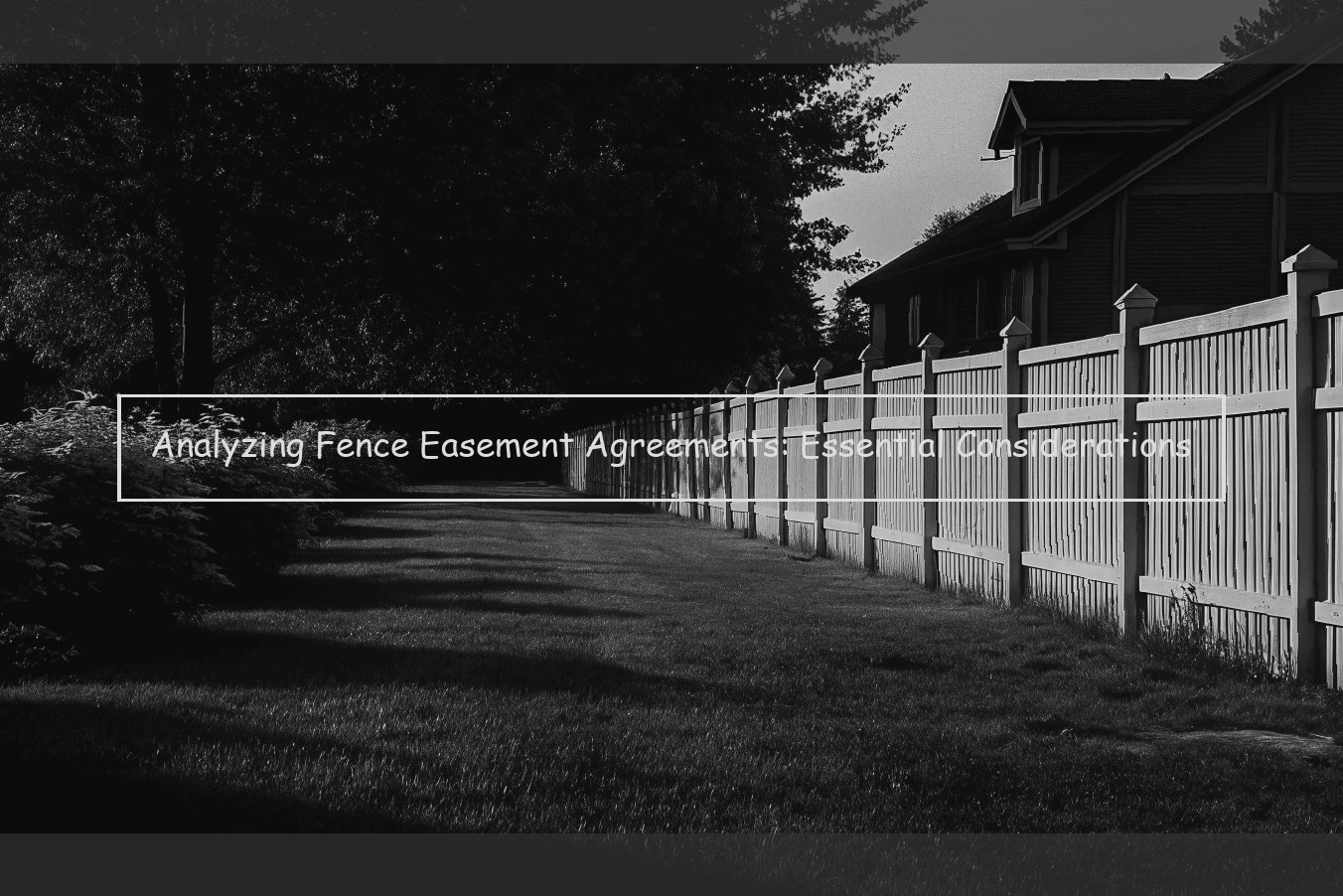Definition of a Fence Easement Agreement
Fence Easement Agreements allow a property owner to cross the property of another in order to access their own land with certain limitations. In the line of business of obtaining these types of agreements, we see them all the time regarding fence lines as well as for other structures of varying types and purpose. Simply put, each property owner may have a claim to title of the land where the fence or structure is built. Assuming that this is the case , the person who built the fence will refuse to obtain title to the property. This results in a cloud on the chain of title to the property for both parties. This can make it difficult, if not impossible to sell, mortgage, or otherwise convey title to the property. A Fence Easement Agreement is a solution to this problem. A Fence Easement Agreement is a Reservation of Easement which states that the property owner does not claim title to the land but reserves the right (an easement) to use the land as it has been used so that the party who built the fence or other structure can avoid the above-mentioned cloud on title.

Legal Framework of Fence Easements
Legal Aspects of Fence Easement Agreements
The legal framework for fence easement agreements is largely provided by the law of easements. Since easements are a creature of law, it is important to first have an understanding of what an easement is and then determine whether the fence agreement changes the existing rights or duties regarding the fence.
A commonly referenced treatise, 2 American Law of Property § 7.1, defines an easement as "a right of one who owns an interest in land to use that land which is in the possession of another or to restrict the use of that land or to perform an act on that land." Given this definition, a fence easement grants either a right to construct a fence on the property of another or the right to place a restriction upon the property of the fence owner, i.e., an obligation to construct or maintain a fence. In other words, the right to encroach on the property of an adjoining owner or the restriction on the adjoining owner arises from the existence of the fence agreement itself.
The requirements for the creation of an easement are generally well settled. Easements can be created by deed, implication, prescription, or implication. A fence agreement easement, i.e., an easement created by a written contract, does not change this legal requirement. To be enforceable, a fence easement must be supported by consideration and must comply with other legal requirements (such as the requirement for certain easements to be recorded). If the fence agreement is incomplete or does not satisfy the requirements for the creation of an easement, it is doubtful that it would create enforceable rights and duties.
It is important that the contract be carefully drafted so that it meets the formalities of the creation of an easement and compliance with any statute of frauds requirements. Moreover, real estate professionals need to be aware that some states impose specific requirements for construction and maintenance of a fence if fenced animals are involved. For example, Michigan provides that certain farm animals may not be kept in an area fenced with a board fence unless a barbed wire is used in addition to the board fence. Mich. Comp. Law Ann. § 433.129. If the correct form of a fence is not used, the neighboring property owner may seek to recover damages to their property and may even be given the right to remove the offending fence.
Creating a Fence Easement Agreement
A fence easement agreement should contain a property description identifying the easement area, and must include a clear indication that the easement is located along a boundary line. In addition, the existing fence must be clearly identified so that it is apparent which side the grant of easement is located, the side of the fence facing the owner granting the easement.
In the granting clause, include language that the easement runs with the land, the language should read as follows: TO HAVE AND TO HOLD the same for and during the full term of this easement, and the payment of a sum of money by Grantor to Grantee, unless sooner terminated by reason of written mutual agreement or the destruction of the existing fence. A fence easement agreement should contain the following language in the provision relating to maintenance of the fence: The parties hereto agree that each will share equally in the cost of maintaining the fence on the mutually exclusive property line between them. Nothing in this paragraph shall limit the right of either Grantor or Grantee to remove the entire existing fence and erect a new fence at their own cost. Upon the removal of the existing fence, the parties agree to erect a new fence, and to share equally in the cost of the fence and its maintenance. Another paragraph should require the fence to comply with all applicable requirements of the county ordinances, specifically, in home or subdivision developments, standard pool fencing may be instituted following the removal of the existing fence. The following paragraph should address entry to the servient tenement: Grantee agrees that prior to entering upon the servient tenement, or entering the fence or fence structures, at any time, Grantee will seek permission to enter such premises from Grantor of this easement. The following paragraph should limit the liability of Grantor in the event someone is hurt while on the premises as a result of the condition of the existing fence: Grantee here by assumes all responsibility for damages to himself, herself or to others which may be caused by, arising out of, or in any way related to the existence of the existing fence or fence structure located upon the Grantor’s property, further, Grantee hereby waives and fully releases Grantor from all claims for damages, loss or injury to persons or property happening in or about the premises arising out of the condition of the existing fence in or about the servient tenement; provided, however, that nothing in this section shall apply to any injuries or damages caused by the active negligence of the Grantor on the premises by entering the premises without permission of the Grantor. The next paragraph should address whether the easement can be assigned to a future property purchaser: The easement granted herein shall run (run with the land) or stay with the land, and shall be binding upon the heirs, legatees, devisees and non-general creditors of the Grantor herein and shall be binding upon the heirs, legatees, devisees and non-general creditors and assigns of the Grantee herein. The last section of the fence easement should address the party to pay attorney’s fees in the event of litigation: The parties hereto agree that in the event any party hereto shall institute litigation against any other party with respect to the subject matter of this easement, the prevailing party shall be entitled to recover reasonable attorneys’ fees and costs incurred in connection therewith, shall be considered an expense of the easement herein granted, and shall be paid by the losing party. As in other easement agreements, a fence easement should be acknowledged by both parties before a notary public and recorded in the county where the property is located.
Common Issues and Resolutions
The inherent nature of fence easements raises the possibility of other disputes down the line. In every court I have been an attorney, judge, or mediator, easement deeds generally state that: (1) a fence may be placed anywhere upon the common boundary line (of the easement) without having to get permission from the adjoining landowner; and (2) the individual landowners have no further rights of possession and no further rights other than their rights to use the fence on the easement.
Several disputes may follow that simple premise.
First, the easement may be poorly defined in the deed so that the landowner does not know where the easement actually is located. A long-time dispute near DeLand, Florida definitely exhibits the possibility of unclear rights of possession. The property was purchased with the understanding that access over the easement was part of the transaction. Over the years, the woods were clear cut and the owner had trouble claiming the full acreage of the easement because it was difficult to access. The dispute is now in mediation; however, the property may need clarification by a court.
Even more serious results can come about should the easement be revoked. In our south Orange County example, a homeowner may wish to build an extensive fence with horizontal beams extending out eight feet from the surface in order to protect a large gardening area from deer. The outcome can depend on whether access rights are expressly stated in the easement deed. If there is no language except the basic easement terms, a wide variety of fences could easily be constructed without the permission of the other landowner. The only restriction is that the easement must be maintained and used for the stated purposes.
Disputes over junk piles on a fence easement are common. These can be easily resolved if the landowners have the discipline to honor the easement. For example, in our Central Florida Neighborhood Watch Group, a homeowner entered into a fence easement and attached a dumpster to his fence that was intended for other uses. When the dumpster was full, the other landowner complained to the residential association . The police were called but only mediated the situation between the landowners. Eventually, both parties settled the dispute out of court when the homeowner moved the dumpster.
We had a similar case in Calico Trace in Ormond Beach. We had a fence easement with a walking path before the Orange Road Extension included both a bicycle and hiking trail. Unfortunately, the homeowner nearest the fence left his garbage cans on the path after every pickup. This occurred several times and one of the other homeowners paid to have the garbage cans moved to a more suitable location. In the meantime, the homeowner who received the information from the other landowner went online and began to complain about the situation.
Jack Sutherland called for a Neighborhood Watch meeting and we had a great turnout, including the homeowner who had the garbage can problem. The homeowner explained how the error occurred and offered to pay full restitution. The group then approved a policy that the Neighborhood Watch would handle these issues in the future involving the fence easement and the easement owners in the neighborhood. The problem was resolved to the satisfaction of all parties involved without legal means.
Many disputes over fence easements revolve around the right to remove trees and brush from the property for easier access. Again, the response depends on whether there is any language in the easement other than the required standard terms. In one County, the Circuit Judge ruled that a fence easement owner has the right to access the fence area and trim or prune any tree or shrub without seeking permission from the other landowner.
In more serious circumstances, the easement owner may enter upon the other owner’s land without consent or notification. This could result in a trespass action where the costs of both efforts would be paid for by the trespasser. Even though this scenario seems unlikely, you should take steps to control the access to your fence easement. One central Florida Neighborhood Watch we represent holds all regular meetings in their neighborhood. This approach minimizes any possible problems and is regarded by the members as a proactive effort to keep the peace in their neighborhood.
Advantages of a Fence Easement for Landowners
In addition to avoiding future issues and the possibility of litigation, fencing easement agreements offer a number positive benefits to property owners. These benefits include:
1. Allows a property owner to retain the benefit of a fence along the boundary line An acre of well-manicured grass and a fence separating two properties are common sights in many suburban neighborhoods. If a fence is well-constructed, both neighbors may appreciate it. As previously noted, fences can serve as a visual barrier to privacy from neighboring houses and yards. Fences can be decorative or used for functional purposes, as with retaining walls, driveways, swimming pool enclosures, pet enclosures, and restricting access to other property. Regardless of the type of fence, property owners investing in building a fence along a common boundary line may want to consider a written fencing easement agreement.
2. Avoids disputes regarding maintenance and repair Many property owners assume that a fence on a common boundary line is considered jointly owned and thus either neighbor is responsible for any necessary maintenance and repairs. The fence is not jointly owned, however, unless both parties own the property on either side of the fence. Even if the fence is considered to be jointly-owned (such as for fences that are built on the property line), there is no law requiring either party to repair or maintain a common fence.
A fencing easement agreement can help avoid the quiet (and sometimes tumultuous) wars between neighbors when one neighbor feels strongly the other neighbor is abandoning their responsibility to repair and maintain a fence. A fence easement agreement clearly sets forth both neighbors’ rights and obligations regarding the fence. It can provide a required frequency for regular inspections for maintenance and a written protocol for making and sharing inspection reports. The fencing easement can also require repair and maintenance of the fence for both neighbors, or potentially apportion the responsibility if repairs are only needed on one side.
3. Preserves goodwill and fosters neighborly relations Undoubtedly, many community board meetings and neighborhood happy hours fall prey to conversations about the neighbor who painted their front door bright green or leaves their dog’s deposits in the public park for all to enjoy. However, most property neighbors are friendly or cordial. Having a fence easement agreement in place for a fence on a common boundary line can help preserve goodwill and neighborly relations by providing both neighbors with peace of mind. The fence easement agreement can memorialize the fence height, style, aesthetic and maintenance. The fence easement agreement can specify who owns the fence, who is responsible for its inspection, repair and maintenance, and apportion the cost of repairs and maintenance. The fence easement agreement can even require both neighbors to confer in advance before making any alterations to the fence.
Procedures for Creating a Fence Easement
Some fence easements are created by contract between a property owner and their neighbor. In these instances, the parties can memorialize their agreement with a fence easement document which identifies the place where the fence will be located as well as the rights and responsibilities of the parties to the fence easement.
Many fence disputes arise because one neighbor puts up a fence that encroaches into the property of the other neighbor or is otherwise placed subject to that neighbor’s rights (for example, a neighbor has the right to install and maintain a fence but not a permanent structure, like a retaining wall) or places the fence in a location abutting an easement held by a utility company. One way to avoid these future problems is for the neighbor that wants to install a fence to obtain written permission from the neighbor (and/or any entities covering parts of their property) to place a fence on or in the neighbor’s property, easement, etc. If you are a property owner without much (or any) need for fences, or additional fences, on your property, this could be a good way to secure use of a portion your property as a buffer against a neighbor’s future plans to install a fence.
Regardless whether a fence was established with an express agreement , neighbors can establish and also gain rights using a fence through an easement by estoppel. An easement by estoppel typically arises when a neighbor creates a fence in reasonable reliance of an oral (or sometimes even a written) promise made by the adjoining landowner. While the neighbor can only establish an easement by estoppel to the extent that he "substantially changed his position" in reliance upon the adjoining landowner’s promise, if that standard is satisfied, if a homeowner later sells their property without clearly reserving a right to remove the fence, the fence will be deemed to be an appurtenant easement, encumbering the property of the homeowner who sells their property.
Whether an easement is established by agreement or by estoppel, there are some standard terms that are generally included in a fence easement draft. Ultimately, while there are some standard terms for a fence easement, parties to a fence easement can include any term or condition so long as it does not violate zoning, building or other laws or public policy. By doing so, parties can memorialize their agreement and understandings about the location of the fence and its maintenance before a problem arises.



